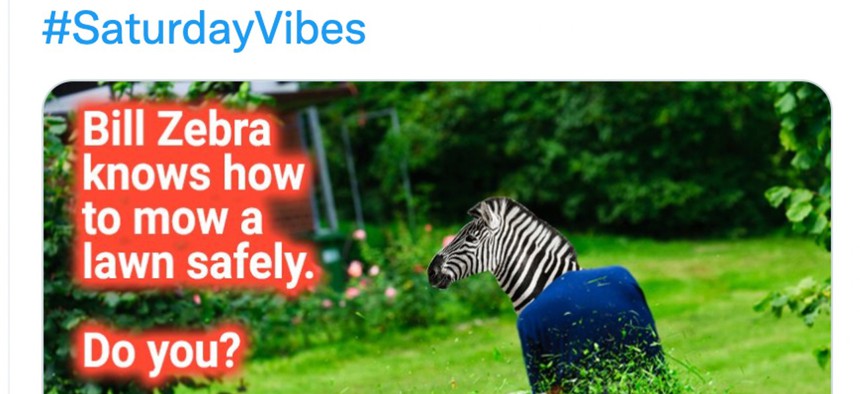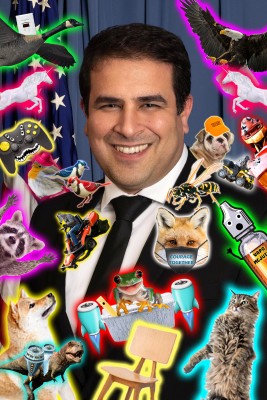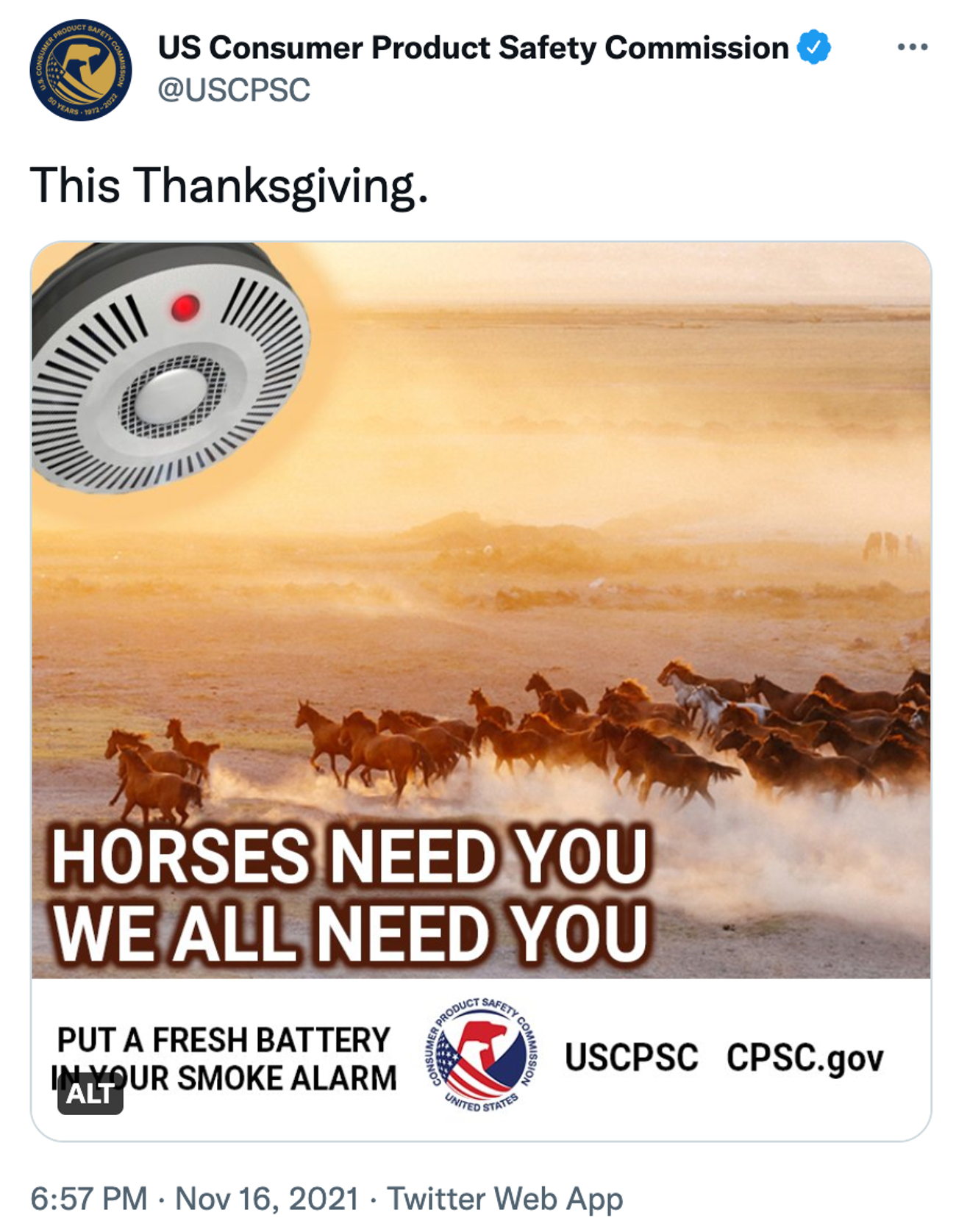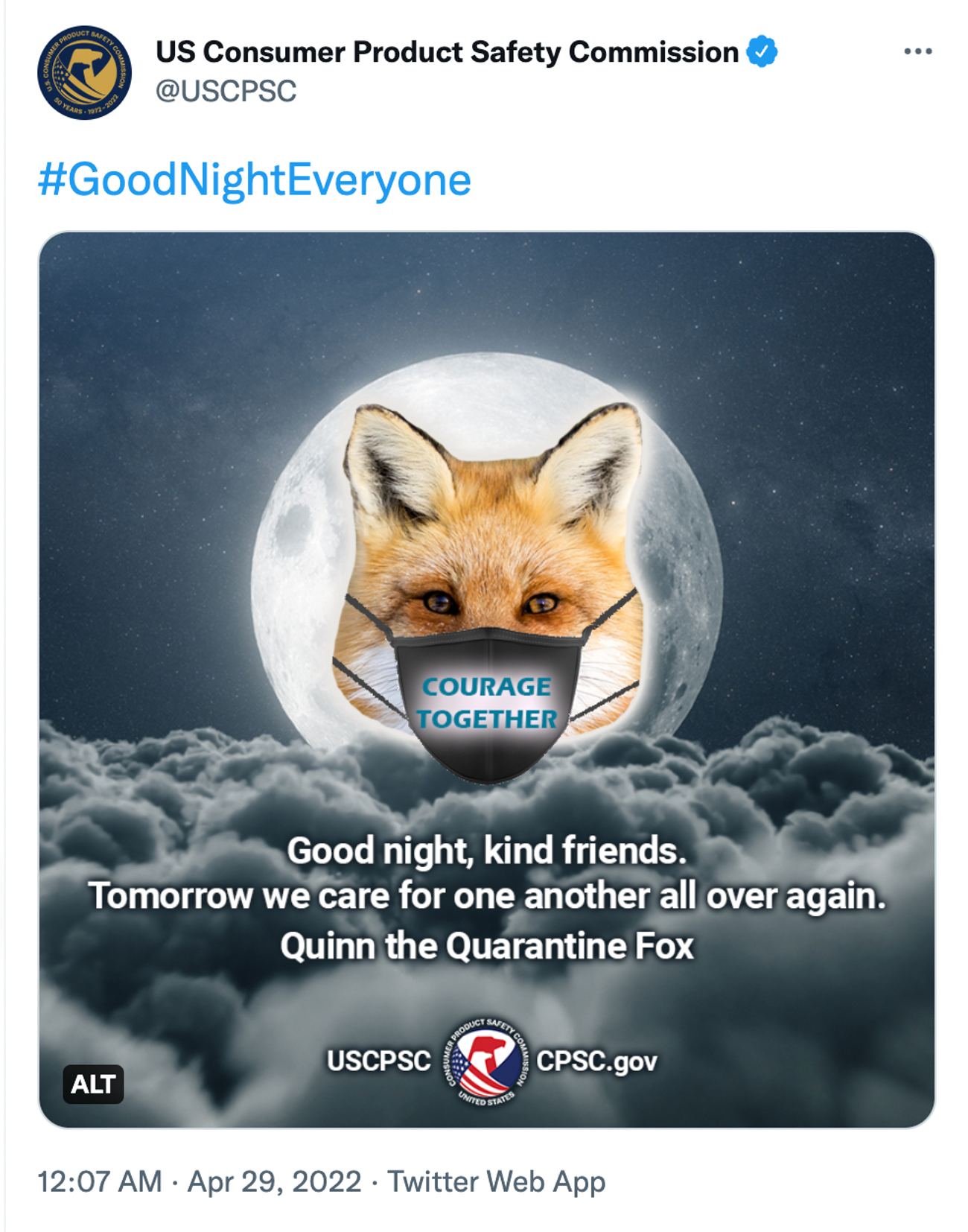
Tweet by @USCPSC/Screengrab by GovExec
How One Federal Agency Meme-d Up Its Social Media
The Consumer Product Safety Commission wants to educate, while also "trying to be relevant and engage the public in a fun and different way.”
If you’re on Twitter, you may have come across a tweet from the U.S. Consumer Product Safety Commission.
Maybe “The Adventures of Pasta Frog” reminded you to pay more attention to your pan while cooking. Or a dinosaur with a jetpack cautioned you “it’s not always this easy to find something dangerous.” Quinn the Quarantine Fox could have wished you a good night. It could have also been Bill Zebra sharing tips on lawn mower safety.

The independent federal agency, which has about 545 employees, has amassed 156,700 Twitter followers since joining the platform in January 2009. What may have attracted many of those followers is the agency’s strategy starting in September 2016 to use funny and sometimes bizarre graphics and memes (often with recurring characters) to inform the public of the latest safety tips, in addition to sharing product recall alerts and other content. The agency is also active on Facebook and Instagram, featuring the same content as Twitter, and its social media presence has been featured by a variety of news outlets.

social media specialists at
the Consumer Product Safety Commission.
(Courtesy of Joseph Galbo)
“I think a lot of digital government professionals are not pleased with the fact that a lot of the public feels disconnected from their federal government because as federal employees we spend a lot of time every day thinking how can we provide better services to people,” said Joseph Galbo, a social media specialist at the agency. “Of course, we're educating consumers about product safety hazards, but we are also trying to be relevant and engage the public in a fun and different way.”
Some of the agency’s memes have been archived by the Library of Congress and the commission even tweeted “birds are real” – a nod to the "birds aren’t real” parody conspiracy theory, fueled by Gen Z – and used the opportunity to advertise its website through a series on two birds having a chat (invitations to a potluck dinner were also discussed).
Government Executive recently spoke with Galbo – who the kids might call a “meme lord” – about the agency’s social media presence and strategy. The interview has been edited lightly for length and clarity.
GE: First, you could start off by telling me how you decide what content to post, obviously it's very engaging, it's very different from what we see kind of from the typical federal agency. Can you kind of walk us through the process?
JG: Yeah, absolutely. So, at CPSC, we have a broad jurisdiction, thousands of consumer products that we are responsible for and then a number of those products tend to cause injuries or deaths every year, so what we do is we have a kind of seasonal calendar and as consumers are using a product more throughout the year, we'll decide that it's time to basically run education campaigns on how the public can use those products more safely. So, a lot of times what you're seeing is the social media version of our safety tips that we put out across all forms of media: earned media, paid advertising, you name it.
On social media, of course, audience expectations are very different for the type of content that people are going to experience. So, we try to use a very fun and very engaging sort of approach and that's where you'll see us using talking dogs and flying cats and dinosaurs with jetpacks and bikers riding through a mountain being chased by flying animals. So, it's just a very fun, offbeat and certainly unconventional approach to injury prevention messaging and public health messaging.
GE: So, say you want to do the dinosaurs with the jetpacks, do you have to get approval for that? Who is involved in making those decisions on what you want to share?
JG: I think sometimes when people look at the social media channels, they might think it's just, oh, some person doing whatever they want and that's not the case. This is still the federal government, there's still reviews to be had and it is a team approach when creating these things so at CPSC the public affairs team is about 15 people at this point. The vast majority of those people are public affairs officers who are working on press releases and the traditional earned media side of things and then on the social media team, you have myself and you have my colleague named Dan, who just started a couple weeks ago, actually. So, it’s a pretty small team overall as digital teams go and one thing we'll try to do is work closely with our colleagues in public affairs to kind of refine our messages and come up with the type of approach that we want to take that year for a campaign. And then once the graphics are created and usually it'll be me that takes the lead on the creative for those, they'll go to my supervisors: our deputy director of communications and our director of communications. They'll provide any notes and they'll also provide the final approval before the graphic is released. We've gotten that process down to a pretty well-oiled machine.
It's not uncommon to get an approval within 30 minutes to an hour of a graphic being sent up the chain and it's, again, one of the benefits of working at a small agency is that you have those very quick approval times for stuff sometimes and, thankfully we have that here. I think it's what allows us to be so responsive to the conversations that are happening on social media and also allows us to have this really fun and unconventional voice that's different than anything you see across government.

GE: When did this approach to social media start? Was it always like this?
JG: There's a very specific date actually. So, September of 2016 we ran an experiment between some traditional style, social media graphics and some more unconventional, what we called at the time, “meme inspired social media graphics,” and that based on that experiment and how well the meme graphics performed, we basically said, okay, we're going to do that a lot more often. And then over the next few months we noticed that the meme strategy continued to work and eventually it became our primary voice on social media. I will say it's, it's something that we do enjoy doing and I think one of the reasons we've stuck with it is because we continue to see the public engage with it. But I like to say that we want to do what works, especially at a small agency where you have such limited resources, you don't really have time to waste time doing things that don't work.
What I say to people around here is we have a lot of fun with this strategy. It's very engaging. The public still likes it. But you know someday they might not and that's okay Then we'll just do something else. I think being responsive to what the public wants and what the public engages with is always going to be the priority for us.
GE: Now have you ever had to maybe explain to maybe older or less social media savvy colleagues, what you're doing? I see that only 16% of your agency’s personnel is 34 or under, according to the Office of Personnel Management’s data. Have you ever gotten any questions or pushback?
JG: Yeah, I mean all the time and I will say it has generally nothing to do with the age of our supervisors. I've worked with incredible supervisors the entire time I've been at CPSC, most of them a few generations older than myself and I think one thing that's been nice is that everybody kind of gets that this is working.
And when I do have to provide an explanation, it's more along the lines of “Hey, well, what cultural references are we making here? What are the kinds of little Easter eggs we're including in the graphics? Could you give a deeper explanation of why you're about to post a picture of two cyclists in a forest where there's red smoke?”
And obviously, for anyone who's watched the latest season of Stranger Things, that's a very, thinly veiled reference to this past season. So, those are the types of moments where I'll get questions…But I have to say overall I've found a very supportive leadership at CPSC and I think that's a 100% why this strategy has been able to endure for all this time because again, everybody understands that it's working and that if it's working, it means we should continue to do it.
GE: Have any public affairs officials or other social media people from other federal agencies ever come to you and asked for assistance with their own social media?
JG: Yeah, all the time. There's actually a very interconnected network of digital communication professionals in the federal government. Through the General Services Administration there's a listserv where all digital media professionals can sign up and we kind of knowledge share and share best practices. GSA has also established a social gov board, which is something that I sit on, and that's a collection of digital media professionals from across agencies and missions, again, just kind of getting together and talking to each other about, “hey, what's working and, what could we be doing to help each other out,” as, we try to message to the public
So yeah, there's really a wonderful community of digital specialists and I do get folks asking a lot of questions, not just about our organic strategy, but also our paid social media strategy. We do do paid social media advertising, and that's kind of unique within the government. There are some agencies that have been doing it for years and are way out ahead on it. And then you have other smaller agencies usually who are just trying to experiment with, “hey, is this appropriate for us? How did you get these things approved? Because maybe we could do that over here at our agency.” It's a lot of that type, almost consulting. It's been really great actually and I've learned so much from my colleagues across government. It's been wonderful.

GE: Oftentimes the narrative with government is that it's slow, they have antiquated technology and it's not really with the times. So, with what you're doing in social media, how does that kind of square with that narrative that's often out there?
JG: We're always mission-focused and we're always trying to stick with the primary mission of educating consumers about product safety hazards. That's our bread and butter. That is what we do. I think at a larger scale, bigger picture, we're also trying to build a deeper engagement with the public and their government, which I think is something as I talk to people across federal agencies, everyone is trying to do a little bit. I think a lot of digital government professionals are not pleased with the fact that a lot of the public feels disconnected from their federal government because as federal employees we spend a lot of time every day thinking how can we provide better services to people?
So, I think it's definitely something that is always in the back of my mind and as we've continued with this strategy we try to keep as almost a North Star; of course, we're educating consumers about product safety hazards, but we are also trying to be relevant and engage the public in a fun and different way.
I think a lot of that old thinking about well government is out of touch or government doesn't have this, that, or the other thing, I mean, some of those things are true, but that's largely what I have not seen across the social media space in the federal government. You actually have a lot of great, innovative social media work happening out there that goes totally up against the traditional thinking of government being slow or out of date.
I will say I think smaller federal agencies where you don't have as much bureaucracy, where the approval processes can be a little bit faster and a little bit more fine-tuned, do have a better opportunity to kind of do some of this more innovative and creative. Whereas at larger agencies where you have a much bigger approval process or more voices involved in the conversation, it can be a little bit more difficult to make that happen…But I'm encouraged every day, every time I speak to someone who works in social, in the government, you hear them suggesting innovative ideas and fighting for innovative ideas.
And I think if there's one thing, I would want the public to know, it's that, government in social media is not a bunch of people just kind of sitting around happy with the status quo. It’s a lot of times I find the exact opposite: it's folks fighting to do innovative things and fighting to bring the government to people in a really engaging way.
GE: Is there anything else I didn't ask about that you think I should know or be aware of? Anything else you want to add?
JG: Well, we always ask people to follow us, please. We post a lot of fun graphics and we do post a lot of fun memes. We also post some very vital health and safety information. So, if you're not following us on Facebook or Twitter or Instagram, please do so. Also, our email list, if you, if memes, aren't your thing and you really do just want recalls from us or to see how we message when we're just doing like the serious side of things, our emails are very straightforward and very, kind of just the facts, so please feel free to subscribe too.







